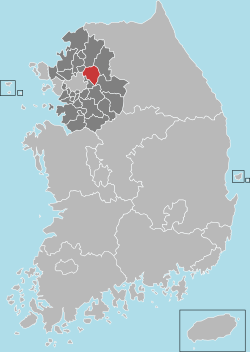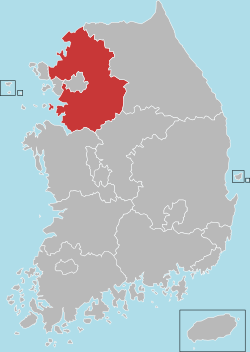Namyangju
Namyangju (Korean pronunciation: [na.mjaŋ.dʑu]) is a city in Gyeonggi Province, South Korea. To the east is Gapyeong County, to the west is Guri City, and to the north is Pocheon City.
Namyangju 남양주시 | |
|---|---|
Specific city | |
| Korean transcription(s) | |
| • Hangul | 남양주시 |
| • Hanja | 南楊州市 |
| • Revised Romanization | Namyangju-si |
| • McCune-Reischauer | Namyangju-si |
 | |
 Flag | |
 Location in South Korea | |
| Country | |
| Region | Sudogwon |
| Administrative divisions | 6 eup, 3 myeon, 7 dong, ?? gu |
| Area | |
| • Total | 458.03 km2 (176.85 sq mi) |
| Population (December 31, 2016) | |
| • Total | 662,154 |
| • Density | 1,445.66/km2 (3,744.2/sq mi) |
| • Dialect | Seoul |
History of Namyangju
Namyangju historical character: Jeong Yak-yong, also Jeong Yag-yong or Dasan[茶山] (1762–1836), was a leading Korean philosopher during the Joseon Dynasty. He is widely regarded as the greatest of the Silhak thinkers, who advocated that the formalist Neo-Confucian philosophy of Joseon return to practical concerns. Jeong Yag-yong and his brothers were also among the earliest Korean converts to Roman Catholicism. Jeong was born, and also ended his days, in modern-day Namyangju, Gyeonggi province
- 1950 October to early 1951 Namyangju Massacre.[1]
- 1980 April 1 Namyangju County was made with Guri-eup, Migeum-eup, Jinjeob-myeon, Jingeon-myeon, Hwado-myeon, Sudong-myeon, Wabu-myeon, and Byeolnae-myeon (2 eup, 6 myeon)
- 1980 December 1 Wabu-myeon became Wabu-eup (3 eup, 5 myeon)
- 1983 February 15 Jingeon-myeon Yangji-ri, Onam-ri, Palheon-ri were absorbed by Jinjeob-myeon
- 1986 January 1 Guri-eup became Guri City (2 eup, 5 myeon)
- 1986 April 1 Wabu-eup Joan branch office became Joan-myeon (2 eup, 6 myeon)
- 1989 January 1 Migeum-eup became Miguem City (1 eup, 6 myeon)
- 1989 April 1 Jinjeob-myeon became Jinjeob-eup (2 eup, 5 myeon)
- 1989 April 1 Toegyewon branch office became Toegyewon-myeon (2 eup, 6 myeon)
- 1991 December 1 Hwado-myeon became Hwado-eup (3 eup, 5 myeon)
- 1992 April 1 In Jinjeob-eup, Onam branch office opened.
- 1995 January 1 Migeum City and Namyangju County were merged. (3 eup, 5 myeon, 6 dong)
- 1995 May 6 Onam branch office became Onam-myeon (3 eup, 6 myeon, 6 dong)
- 2001 September 12 Jingeon-myeon became Jingeon-eup (4 eup, 5 myeon, 6 dong)
- 2001 September 12 Onam-myeon became Onam-eup (5 eup, 4 myeon, 6 dong)
- 2005 June 1 In Byeolnae-mueon, Cheonghak branch office opened.
- 2006 January 20 Pungyang branch office opened; It has jurisdiction over Onam-eup, Jinjeob-eup, Toegyewon-myeon, Byeolnae-myeon
- 2006 November 20 In Hwado-eup, Dongbu branch office opened.
- 2008 October 7 The population reached 500,000 (the 13th city in South Korea to do so).
- 2009 December 14 Cheonghak branch office closed.
- 2011 September Namyangju Organic Museum opened, world's first museum of organic agriculture.[2]
Administrative divisions
- 5 Eup
-Hwado
-Jinjeob
-Jingeon
-Onam
-Wabu
-Toegyewon
- 3 Myeon
-Byeolnae
-Joan
-Sudong
- 7 Dong
-Byeolnae
-Dasan 1
-Dasan 2 - Suseok, Donong, Jigeum
-Geumgok
-Hopyeong
-Pyeongnae
-Yangjeong - Ilpae, Ipae, Sampae
Location
Namyangju is a northeastern city which is part of the ring around Seoul. Seoul Ring Expressway passes through.
Jungang Line passes through Namyangju. - Donong station, Yangjeong station, Dukso station, Dosim station, Paldang station, Ungilsan station
A refurbished Gyeongchun Line reopened in late 2010 - Byeollae, Toegyewon, Sareung, Geumgok, Pyeongnae-hopyeong, Maseok stations are in Namyangju.
The Transportation and Construction Committee of the National Assembly has approved that Line 4 will be extended from Danggogae to Jinjeop, Namyangju.
The 2012 Munhwa Broadcasting Corporation drama Arang and the Magistrate, starring Lee Joon-gi, Shin Min-ah and Yeon Woo-jin, were filmed on location in Namyangju.[3]
Education
There are 2 campuses of Gyeong Hee graduate school and Gyeong bok college, 15 high schools, 29 middle schools, and 55 elementary schools.
Historic Landmarks
The royal tomb of Princess Hwahyeop, a Joseon dynasty princess, was discovered in Sampae-dong in 2015. Excavations in 2016 unearthed stone tablets detailing eulogies to her written by King Yeongjo, Crown Prince Sado, and King Jeongjo.[4]
Namyangju Organic Museum
Namyangju is rapidly developing a reputation as a regional centre of excellence for organic farming. The Namyangju Organic Museum, the world's first museum dedicated to the history and development of organic agriculture, opened in September 2011. It is located west of Seoul and on the shores of the River Han. The museum caters for young and old, it includes a timeline of organic farming developments, and there are exhibits of traditional Korean farming practices tied to the 24 seasonal divisions of the year. The museum's opening coincided with Namyangju hosting the 17th IFOAM Organic World Congress.[2]
Products
The sweet pears are exported to the USA, Japan, Canada. Organic vegetables are cultivated with ecofriendly methods.
Gorosoei is a special product made in the Namyangju area. It is medicinal water which has abundant minerals.
The term "Gorosoei" comes from "Gollisu" meaning "water for bones." The sap is extracted at Sudong-Myeon, Mountain Jugeum in Mount Chungnyeong Natural Recreation Forest, Mount Cheonma in Palhyeon and Onam township.[5]
Twin towns – sister cities
See also
References
- Charles J. Hanley (Dec 6, 2008). "Children 'executed' in 1950 South Korean killings". San Diego Union-Tribune. Associated Press. Retrieved 2012-08-30.
- Paull, John (2011) "A Postcard from Korea: Worldʼs First Organic Agriculture Museum", Journal of Bio- Dynamics Tasmania, 104:11-14.
- Suk, Monica (22 June 2012). "Lee Joon-gi, Shin Mina reveal behind-scene footages for new TV series' 1st shooting". 10Asia. Archived from the original on 2014-02-03. Retrieved 2012-10-15.
- Kim, Young Shin (29 December 2016). "Tomb of Joseon princess discovered". Korea.net. Retrieved 27 July 2017.
- Welcome to the official Namyangju City Web site Archived 2006-01-01 at the Wayback Machine
- "Sister City". nyj.go.kr. Namyangju. Retrieved 2020-04-13.
External links
- City government website (in English)
- City Council website (in Korean)
- "2015년 인구주택총조사 전수집계결과 보도자료" [2015 Population and Housing Census]. Statistics Korea.
